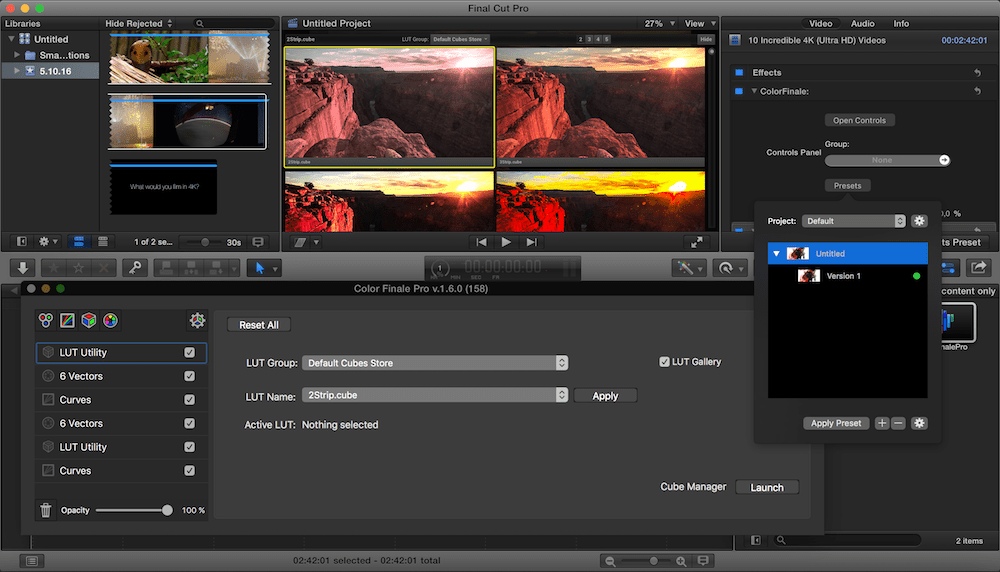
- #Cinema grade vs color finale update
- #Cinema grade vs color finale pro
- #Cinema grade vs color finale software
- #Cinema grade vs color finale professional
Basically setting the Exposure slider to 1 means you've increased it by one stop up." We’ve actually taken numerous images with the cameras and test charts shot at the different exposure settings and matched those to our slider control.

The Inspector pane is where you control color management, along with exposure, contrast, pivot, temperature, tint, saturation, and sharpness.Īccording to Lavrov, "Our Exposure tool is calibrated to real camera F-stop numbers.

In fact, it's a separate primary grading panel, not unlike the functions of the Basic tab within Adobe's Lumetri panel. The Inspector pane is a lot more than simply the place from which to launch the Layers panel. The user interface is designed around two components: the FCPX Inspector controls and the floating Layers panel. It packs a lot of punch and honestly, there's a lot more than I can easily cover with any depth here. Primary color correctionĬolor Finale 2 is intended to give Final Cut users similar grading control to that of Resolve, Avid Symphony, or Adobe Premiere Pro's Lumetri panel. This focus means better optimization and a better user experience.
#Cinema grade vs color finale pro
Color Finale 2 Pro supports more features, such as Tangent panel control, ACES color space, group grading, mask tracking, and film grain emulation.Ĭolor Finale has been designed from the beginning as only a Final Cut Pro X plug-in. It comes in two versions - standard and Pro.
#Cinema grade vs color finale update
The update has been optimized for Metal and the newest color management, such as ACES. This brings us to the end of 2019 and the release of Color Finale 2.0, which has been redesigned from the ground up as a new and improved version of the original. If you want to do advanced correction in FCPX with the least amount of clicking back-and-forth, then there are really only two options: Coremelt's Chromatic and Color Finale. It's about having a tool that is properly designed for a grading workflow. However, effective and fast color correction isn't only about looks presets, LUTs, and filters. Over the course of eight years of Final Cut Pro X's existence, the internal color tools have been improved and even more third-party color correction plug-ins have been developed.

The ideal situation is to never leave the editing application, but that requires more than just a few, simple color correction filters. Roundtrips pose a few issues, including turnaround time, additional media rendering, and frequent translation errors with the edit and effects data between the edit and the grading application. So you might ask, why bother? But if you edit with Final Cut Pro X, then this requires a roundtrip between Final Cut and a dedicated grading suite or application.
#Cinema grade vs color finale professional
In the last year Lavrov created both Cinema Grade, now owned and run by Riddle, and Color Finale 2.0, owned and run by Lavrov himself under his own company, Color Trix Ltd.īy focusing exclusively on the development of Color Finale 2.0, Lavrov can bring to market more advanced feature ideas, upgrades, and options with the intent of making Final Cut a professional grading solution.įor many, Blackmagic Design's DaVinci Resolve and Fimlight's Baselight systems set the standard for color correction and grading.

#Cinema grade vs color finale software
One of the earliest was Color Finale - the brainchild of colorist/trainer Denver Riddle and ex-DI supervisor and color correction software designer Dmitry Lavrov. Final Cut Pro X initially offered only basic color correction tools, which were quickly augmented by third party developers. HDR, camera raw, and log profiles are an ever-increasing part of video acquisition, so post-production color correction has become an essential part of every project. We all know FCPX now has colour wheels and curves, but what about doing more advanced colour corrections? How about a plugin that can track masks, use ACES colour spaces and add film grain? Oliver Peters takes a look a the new Colour Finale 2.


 0 kommentar(er)
0 kommentar(er)
